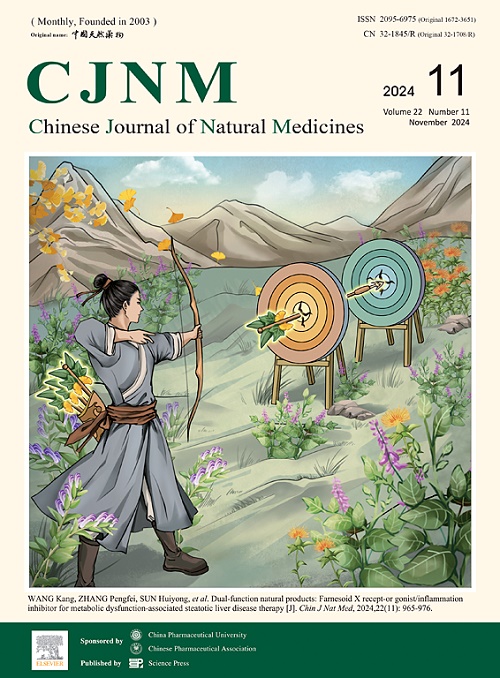Ziyuglycoside II suppressed the progression of osteosarcoma by coordinating estrogen-related receptor gamma and p53 signaling pathway
IF 4.9
2区 医学
Q1 INTEGRATIVE & COMPLEMENTARY MEDICINE
引用次数: 0
Abstract
Osteosarcoma (OS) is the most prevalent primary malignant bone tumor affecting children and adolescents. Despite ongoing research efforts, the 5-year survival rate has remained stagnant for many years, highlighting the critical need for novel drug development to enhance current treatment protocols. Ziyuglycoside II (ZYG II), a triterpenoid saponin extracted from S. officinalis, has recently demonstrated antitumor properties. This study evaluates the antitumor effect of ZYG II on osteosarcoma and elucidates its mechanism of action through the co-regulation of p53 and estrogen-related receptor gamma (ESRRG), which inhibits disease progression. The research employs in vitro experiments using multiple established osteosarcoma cell lines, as well as in vivo studies utilizing a nude mouse model of orthotopic xenograft osteosarcoma. Additionally, ESRRG shRNA was used to construct stable ESRRG-reducing OS cell lines to investigate the molecular mechanism by which ZYG II exerts its anti-osteosarcoma effects through the co-regulation of ESRRG and p53. Results indicate that ZYG II administration led to decreased OS cell viability and reduced tumor volumes. Furthermore, cell cycles were arrested at the G0/G1 phase, while the proportion of apoptotic cells increased. Expression of p53, ESRRG, p21, Bax, Cleaved Caspase-9, and Cleaved Caspase-3 proteins increased, while expression of CDK4, Cyclin D1, and Bcl-2 proteins decreased. Multiple ZYG II and ESRRG docking patterns were simulated through molecular docking. Comparing the pharmacodynamic response of ZYG II to OS cell lines with reduced ESRRG and normal expression demonstrated that ZYG II inhibits osteosarcoma progression, induces cell cycle arrest, and promotes cell apoptosis through the coordination of p53 and ESRRG. In conclusion, ZYG II inhibits osteosarcoma progression, leads to cell cycle arrest, and promotes cell apoptosis through synergistic regulation of p53 and ESRRG.
紫愈糖苷II通过协调雌激素相关受体γ和p53信号通路抑制骨肉瘤的进展
骨肉瘤(OS)是影响儿童和青少年的最常见的原发性恶性骨肿瘤。尽管正在进行研究,但5年生存率多年来一直停滞不前,这凸显了开发新药以增强当前治疗方案的迫切需要。紫榆苷是一种从山茱萸中提取的三萜类皂苷,近年来被证明具有抗肿瘤作用。本研究评价了ZYG II对骨肉瘤的抗肿瘤作用,阐明了其通过协同调节p53和雌激素相关受体γ (ESRRG)抑制疾病进展的作用机制。该研究采用多种已建立的骨肉瘤细胞系进行体外实验,以及利用裸鼠原位异种移植骨肉瘤模型进行体内研究。此外,利用ESRRG shRNA构建稳定的ESRRG-reducing OS细胞系,研究ZYG II通过ESRRG和p53共同调控发挥其抗骨肉瘤作用的分子机制。结果表明,ZYG II可降低OS细胞活力,缩小肿瘤体积。细胞周期停留在G0/G1期,凋亡细胞比例增加。p53、ESRRG、p21、Bax、Cleaved Caspase-9、Cleaved Caspase-3蛋白表达升高,而CDK4、Cyclin D1、Bcl-2蛋白表达降低。通过分子对接模拟多种ZYG II和ESRRG对接模式。比较ZYG II对ESRRG表达减少和正常的OS细胞株的药理学反应表明,ZYG II通过p53和ESRRG的协同作用,抑制骨肉瘤的进展,诱导细胞周期阻滞,促进细胞凋亡。综上所述,ZYG II通过协同调节p53和ESRRG抑制骨肉瘤进展,导致细胞周期阻滞,促进细胞凋亡。
本文章由计算机程序翻译,如有差异,请以英文原文为准。
求助全文
约1分钟内获得全文
求助全文
来源期刊

Chinese Journal of Natural Medicines
INTEGRATIVE & COMPLEMENTARY MEDICINE-PHARMACOLOGY & PHARMACY
CiteScore
7.50
自引率
4.30%
发文量
2235
期刊介绍:
The Chinese Journal of Natural Medicines (CJNM), founded and sponsored in May 2003 by China Pharmaceutical University and the Chinese Pharmaceutical Association, is devoted to communication among pharmaceutical and medical scientists interested in the advancement of Traditional Chinese Medicines (TCM). CJNM publishes articles relating to a broad spectrum of bioactive natural products, leading compounds and medicines derived from Traditional Chinese Medicines (TCM).
Topics covered by the journal are: Resources of Traditional Chinese Medicines; Interaction and complexity of prescription; Natural Products Chemistry (including structure modification, semi-and total synthesis, bio-transformation); Pharmacology of natural products and prescription (including pharmacokinetics and toxicology); Pharmaceutics and Analytical Methods of natural products.
 求助内容:
求助内容: 应助结果提醒方式:
应助结果提醒方式:


